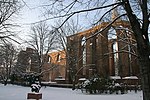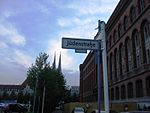Parochialkirche
1702 establishments in the Holy Roman Empire18th-century Calvinist and Reformed churchesBaroque architecture in BerlinCemeteries in BerlinChurches completed in 1702 ... and 3 more
Protestant Reformed cemeteriesProtestant churches in BerlinReformed church buildings in Germany

The Parochialkirche (literally the Reformed parochial church) is a Reformed church in the Klosterviertel neighbourhood of the Mitte borough in Berlin. The church, now a listed building, was built between 1695 and 1703. It is the oldest church in Berlin built as a Protestant place of worship. The church is now used and owned by the congregation of St. Mary's and St. Peter's, the merger of the parishes in the historical city center concluded on 23 September 2005. The congregation forms part of the Evangelical Church Berlin-Brandenburg-Silesian Upper Lusatia, a Protestant regional church body comprising Lutheran, Reformed and united Protestant congregations.
Excerpt from the Wikipedia article Parochialkirche (License: CC BY-SA 3.0, Authors, Images).Parochialkirche
Klosterstraße, Berlin Mitte
Geographical coordinates (GPS) Address Website External links Nearby Places Show on map
Geographical coordinates (GPS)
| Latitude | Longitude |
|---|---|
| N 52.516944444444 ° | E 13.413055555556 ° |
Address
Parochialkirche
Klosterstraße 66-67
10179 Berlin, Mitte
Germany
Open on Google Maps











